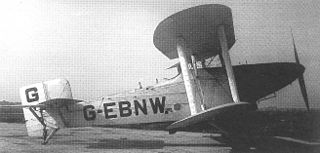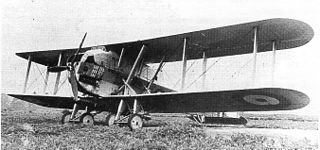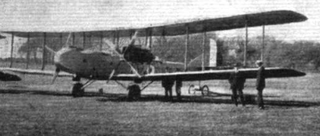
The Hawker Harrier was an experimental biplane torpedo bomber aircraft built by Hawker Aircraft to a specification issued in the 1920s for the RAF.

The Vickers Type 131 Valiant was a British general-purpose biplane produced by Vickers in 1927, with the intention of replacing the Royal Air Force's Airco DH.9As, but was unsuccessful, with only a single example built, which was sold to Chile.

The Hawker Hedgehog was a three-seat reconnaissance biplane, to be used for naval scouting, produced to meet Air Ministry Specification 37/22.

The Fairey Hendon was a British monoplane, heavy bomber of the Royal Air Force, designed by Fairey Aviation in the late 1920s. The aircraft served in small numbers with one Squadron of the RAF between 1936 and 1939. It was the first all-metal low-wing monoplane to enter service with the RAF.

The Avro 549 Aldershot was a British single-engined bomber aircraft built by Avro.

The Short Bomber was a British two-seat long-range reconnaissance, bombing and torpedo-carrying aircraft designed by Short Brothers as a land-based development of the very successful Short Type 184.

The Airco DH.11 was a British twin-engined biplane bomber which was designed to replace the earlier Airco DH.10 bomber. It was designed to use the unsuccessful ABC Dragonfly engine and was abandoned after the first prototype was built.

The Avro 571 Buffalo was a prototype British carrier-based torpedo bomber biplane, designed and built by Avro in the 1920s. It was not selected for service, the Blackburn Ripon being ordered instead.

The Avro 604 Antelope was a British light bomber which was designed and built in the late 1920s to meet a requirement for a light bomber to equip the Royal Air Force, competing against the Hawker Hart and the Fairey Fox II. It was unsuccessful, the Hart being preferred.
The Avro 519 was a British bomber aircraft of the First World War, a development of the Avro 510 seaplane. They were two-bay biplanes of conventional configuration with greatly uneven span. Two single-seat examples, powered by a single 150 hp (110 kW) Sunbeam water-cooled engine, were ordered by the RNAS in early 1916. This was soon followed by orders for two modified aircraft for the Royal Flying Corps. These were fitted with seats for a crew of two and had more powerful (225 hp/168 kW) Sunbeam engines

The Handley Page H.P.24 Hyderabad was a British twin-engine biplane heavy bomber built by Handley Page which served with the Royal Air Force between 1925 and 1933. It was the last wooden heavy bomber to serve with the RAF.

The Blackburn T.4 Cubaroo was a prototype British biplane torpedo bomber of the 1920s. Built by Blackburn Aircraft and intended to carry a large 21 in (533 mm) torpedo, the Cubaroo was one of the largest single-engined aircraft in the world at the time of its first flight.

The Airco DH.3 was a British bomber aircraft of the First World War. The DH.3 was designed in 1916 as a long-range day bomber by Geoffrey de Havilland, chief designer at the Aircraft Manufacturing Company. It was a large biplane with wide-span three-bay wings, slender fuselage, and a curved rudder. It was powered by two 120 hp (89 kW) Beardmore engines, mounted as pushers between the wings. In addition to tailskid landing gear, two wheels were placed beneath the nose to prevent bumping.

The Avro Type 557 Ava was a British twin-engined biplane torpedo bomber of the 1920s. It was developed by Avro to meet a requirement for a heavy torpedo bomber for the Royal Air Force but was unsuccessful, only two prototypes being built.

The Aichi E3A was a reconnaissance seaplane developed in Germany as the Heinkel HD 56 to operate from warships of the Imperial Japanese Navy, which designated it the Type 90-1 Reconnaissance Seaplane. It was a conventional single-bay biplane with staggered wings braced by N-type interplane struts. The pilot and gunner sat in tandem, open cockpits.

The Avro 529 was a twin-engined biplane long-range bomber of the First World War. Two prototypes were built but no production ensued.
The Short N.2B was a prototype British patrol seaplane of the First World War, designed and built by Short Brothers. A single-engined biplane intended to replace Short's successful Type 184, only two were built, the Fairey III being preferred.
The Grahame-White Ganymede was a prototype British heavy night bomber intended to serve with the Royal Air Force in the First World War. A large, three-engined, twin-boom biplane, the sole prototype Ganymede did not fly until after the war had ended, and although an attempt was made to convert the aircraft to an airliner, it was unsuccessful.
The Avro 528 was an unsuccessful large span single-engined biplane built to an Admiralty contract in 1916. It carried a crew of two; only one was built.
The Sunbeam Bomber was a prototype single-engined, single seat bomber aircraft of the First World War. Only one example flew as the type proved to be unsuccessful and was abandoned.















